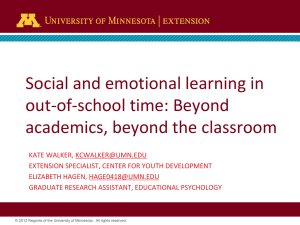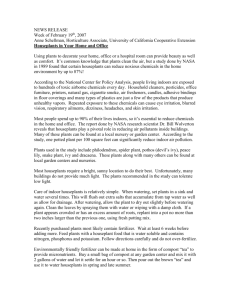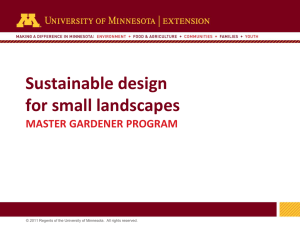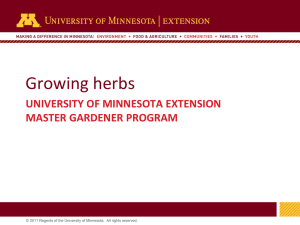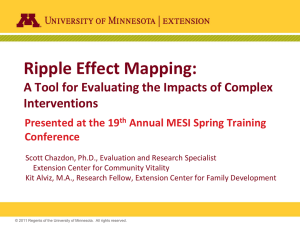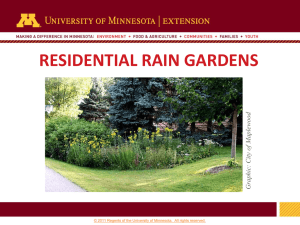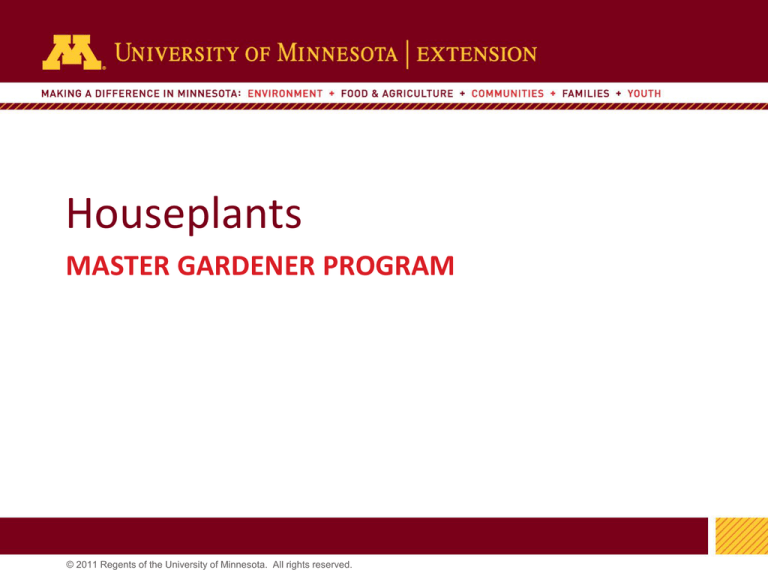
Houseplants
MASTER GARDENER PROGRAM
1
© 2011 Regents of the University of Minnesota. All rights reserved.
CLASS OBJECTIVES
Understand basic growth requirements of
houseplants
Understand how various aspects of light
affect plant growth
Know how to water indoor plants
Know what containers and soil to use
Become familiar with insects/diseases of
houseplants
2
© 2011 Regents of the University of Minnesota. All rights reserved.
WHY GROW HOUSEPLANTS?
Beauty
3
© 2011 Regents of the University of Minnesota. All rights reserved.
WHY GROW HOUSEPLANTS?
To nurture a
living thing
4
© 2011 Regents of the University of Minnesota. All rights reserved.
WHY GROW HOUSEPLANTS?
As part of our
interior design
5
© 2011 Regents of the University of Minnesota. All rights reserved.
WHY GROW HOUSEPLANTS?
To live with
green
plants year
round
6
© 2011 Regents of the University of Minnesota. All rights reserved.
WHY GROW HOUSEPLANTS?
To clean the
indoor air
7
© 2011 Regents of the University of Minnesota. All rights reserved.
WHY GROW HOUSEPLANTS?
To provide
fresh food
(herbs) year
round
8
© 2011 Regents of the University of Minnesota. All rights reserved.
WHY GROW HOUSEPLANTS?
To use
your
creativity
9
© 2011 Regents of the University of Minnesota. All rights reserved.
THERE IS NO SUCH THING AS A
HOUSEPLANT!
Tropical Plant
Desert Plant
Annual/Tender
Perennial Plant
10
© 2011 Regents of the University of Minnesota. All rights reserved.
GOAL: REPLICATE NATURAL
CONDITIONS
11
© 2011 Regents of the University of Minnesota. All rights reserved.
ENVIRONMENTAL FACTORS
Light
Water
Humidity
Soil
Nutrients
12
LIGHT—MOST CRITICAL
Brightness and intensity vary by:
Exposure (North, South, East,
West)
Distance from the light source
Window coverings, film/dirt on the
window
Dust on leaves
Time of year
Artificial light
13
LIGHT
Intensity/brightness
Duration: hours of
light
Quality: color or
wavelength
14
WATERING
Factors that affect
frequency of watering:
Type of plant
Type of Container
Temperature
Humidity in the air
Potting medium
15
WATERING METHODS
Water when the plant
needs it
– Feel the soil
– Water thoroughly
Use water at room
temperature
If water is chlorinated
allow it to stand 24 hours
Improve oxygen level by
using Enki watering can
16
DIFFERENT WATERING METHODS
Some require
consistently moist soil
Some require soil to
dry out between
watering
Avoid water on foliage
Let water run through
17
TOO WET/TOO DRY
Overwatering symptoms:
Lower leaves turn yellow and
drop
Oedema can develop
Adventitious roots on stems
Root rot
Under watering symptoms:
Dry or brown leaf tips/margins
Leaves that turn brown and die
Plants become stunted or
woody
18
BASIC RULE OF WATERING
?
If in doubt. . . don’t
19
© 2011 Regents of the University of Minnesota. All rights reserved.
HUMIDITY
Desert natives prefer
dry air
Tropicals miss their
rainforest
20
INCREASE HUMIDITY
Place plants in pebble filled
trays
Group plants together
Place plant in a bathroom or
near a kitchen sink
Running a humidifier
Move plants away from heat
vents
Grow plants that require high
humidity in a terrarium
Allow plants to spend time
outside in the summer
Select plants that tolerate low
humidity
21
CONTAINERS
Large enough to hold
sufficient soil
Allows for proper
watering – headspace
Non-Toxic
Provisions for
Drainage
Attractive
22
CLAY POTS
Heavy, prevent tipping
Porous – good aeration
Overwatering less of a
problem
Soil dries out faster
Mineral salts and algae
may collect on exterior
Breakable
More expensive than
plastic
23
PLASTIC POTS
Light-weight and easy to handle
Less expensive
Easily cleaned for reuse
Overwatering may be a problem
Often tip easily
Variability in aesthetic appearance
24
SOIL
Soil provides both nutrients and
physical support for the plant
25
ALL-PURPOSE POTTING SOIL
May be soil-less
Must be sterile
Is made of peat moss,
compost, bark, perlite,
sand, loam
combinations
26
SPECIALTY POTTING MIXES
Orchids
Cacti
Palms
Bromeliads
Azaleas
27
FERTILIZATION HINTS
Fertilize every two
weeks March through
September with water
soluble fertilizer at ½
the label rate.
Never fertilize when
plants are dry
When using liquid
solution make sure
some runs out of the
pot
28
FERTILIZATION
Symptoms of insufficient fertilizer:
Pale foliage (especially if Nitrogen is lacking)
Leaf loss
Few flowers
Stunted and unhealthy looking plants
Symptoms of over fertilization:
Hard, stunted growth
Burned leaf margins
Poorly shaped leaves
Wilted leaves (when soil is wet)
29
© 2011 Regents of the University of Minnesota. All rights reserved.
INSECT AND DISEASE CONTROL
Examine plants closely before purchasing
for insects or disease
Isolate purchased plant for 2 weeks
Prune out any bug/disease infested
portion of the plant
Treat plant for specific insect or disease
Never apply any chemicals to a moisture
stressed plant
Avoid misting plants!
30
© 2011 Regents of the University of Minnesota. All rights reserved.
CREDITS AND THANK YOU TO:
Presentation content and pictures provided by
Sue, Hennepin County Master Gardener
Presentation formatting completed by Amy
Johnson, Hennepin County Master Gardener
Information on container types and fertilizer
signs/symptoms used from Carl F. Hoffman,
Extension Horticulturalist for “Indoor Gardening”
presentation
31
© 2011 Regents of the University of Minnesota. All rights reserved.
Discover more at
extension.umn.edu
© 2011 Regents of the University of Minnesota. All rights reserved.
The University of Minnesota is an equal opportunity educator and employer. In accordance with the Americans with Disabilities
Act, this PowerPoint is available in alternative formats upon request. Direct requests to the Extension Store at 800-876-8636.
32

